The Motorcycle Diaries
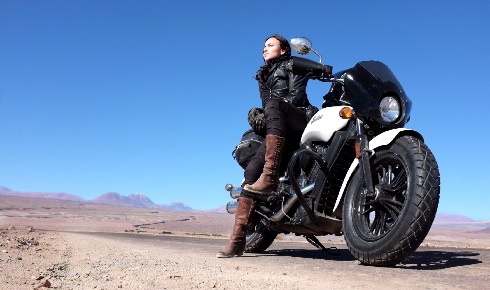
For the last five years Janelle Kaz has combined her love of nature and motorcycles on a two-wheeled intercontinental conservation adventure. She gives The Biologist a taster of the latest leg of her trip, across Chile and Peru, where she meets groups helping to protect otters, armadillos and Andean cats
The Biologist 66(6) p30-33
Nothing about seeking rare and endangered species on a long-distance motorcycle voyage is conventional, especially if you happen to be a woman riding solo through South America on a heritage bike.
My objective when on two wheels is to document wildlife and ecosystem protection. With a background in biology, and a number of years spent developing wildlife and environmental education curricula in Laos, I hope to bring more attention and support to threatened species and those working to protect them.
I’ve been living on a motorcycle for nearly five years now, on different bikes on different continents. Motorcycles have been a conduit for me to reach the furthest-flung conservation and research sites. Also, being a woman alone on a motorcycle seems to be a compelling way to talk about conservation to those who otherwise might not listen.
A collaboration with Indian, the oldest motorcycle manufacturer in the Americas, sent me to Santiago, Chile, to pick up a 2019 Scout Sixty. After a few modifications to make the bike more off-road friendly, my first stop was the Centro de Rehabilitación de Aves Rapaces (CRAR), a rescue centre for birds of prey in Talagante, just south-west of Santiago’s bustling metropolis. In addition to educational outreach, CRAR works in the conservation, rehabilitation and research of raptors in Chile. There to greet me was veterinarian Jürgen Rottman, a respected ornithologist and conservationist. In the early 1970s, as a budding naturalist, Rottman outlined the first list of animals in danger of extinction in the country and disseminated this knowledge to the public in newspapers and on television.
In addition to ongoing conservation work, he now rescues, rehabilitates and releases raptors back into the wild. At the time of my visit there were 25 Andean condors (Vultur gryphus) being cared for, most of them set for future release. The causes of arrival at the centre are diverse, the most common being hunting wounds, theft from nests, collision damage and poisoning. The Andean condors at the centre were the lucky ones, as toxic agricultural poisons such as carbofuran are often used, illegally, to combat predators. When these carcasses are scavenged upon by condors, more deaths ensue.
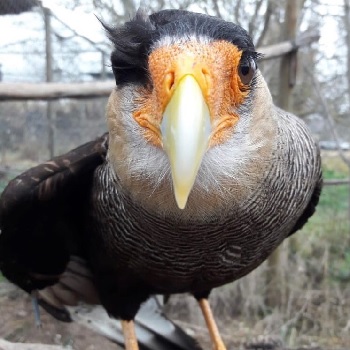 A rescued one-eyed crested caracara in Chile, named Pirata
A rescued one-eyed crested caracara in Chile, named PirataLast year outside Mendoza, Argentina, 34 Andean condors were found dead next to the corpse of a puma, all due to carbofuran. Such tragedy is as heart-breaking as it is needless. Further education outreach and enforcement are needed, but carbofuran is extremely inexpensive and regulating such a vast, rugged landscape is difficult. Rottman considers himself an optimistic conservationist, believing that there is a solution for almost everything. Thanks to the work by CRAR, some of Chile’s condors, hawks, caracaras and owls have a better chance of survival.
Otters and armadillos
Riding from the foothills of the Andes to the frigid waters of the Pacific, my next destination is the rocky coastal habitat of the endangered marine otter (Lontra felina), called chungungo in South America. These otters are the smallest in their genus and are extant within Peru, Chile and Argentina, although their severely fragmented populations are in decline.
Out of the small beach town of Maitencillo the organisation Chinchimén is the first to rehabilitate and release orphaned marine otters back into the wild in Chile. Their most recent rescue arrived dehydrated and suffering from hypothermia and pneumonia. After two months of intensive care the young otter began to flourish and work began to acclimatise her to her natural habitat. Without a proper facility, this entails a volunteer carrying the otter in a crate down a series of steps to the rocky beach daily, letting her swim, play and hunt until she is ready to come back to the crate, before being carried back up the many flights of stairs. Rehabilitating a single otter takes an incredible amount of time and dedication – baby otters learn from their mothers, so without them the learning curve is much slower (up to 18 months).
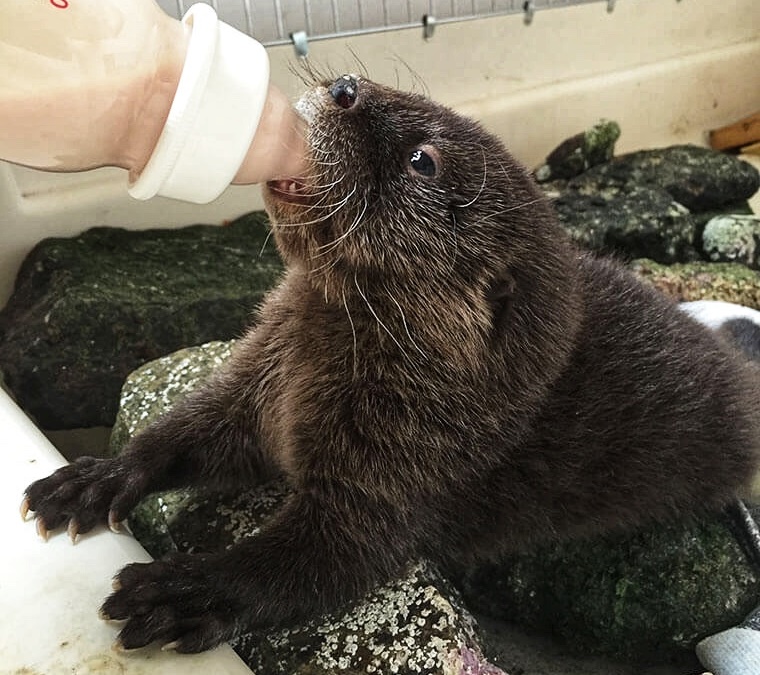 Baby Chungita, an orphaned, endangered marine otter that later became the first otter to be rehabilitated and released into the wild in Chile
Baby Chungita, an orphaned, endangered marine otter that later became the first otter to be rehabilitated and released into the wild in ChileMarine otters rely on aquatic habitats for foraging, yet the distribution of the species is limited where people and domestic dogs use the terrestrial habitats they need for shelter – roaming dogs are a huge threat to marine otters, and many people in the fishing industry see otters as competition for resources and kill them.
In the summer months Chinchimén sets up aquariums on the beach for the public to learn about the small animals that live in the coastal waters. When it is time to let the urchins, crabs, invertebrates and other collected creatures go, the children take part in releasing them back into the wild. The volunteers of Chinchimén have noticed a change in some of the children – they have started to act as guardians, passing on knowledge of the animals and how to keep them safe.
This amazing group of volunteers is not only dedicated to helping endangered marine otters, but also raising awareness, educating the public and increasing empathy among children.
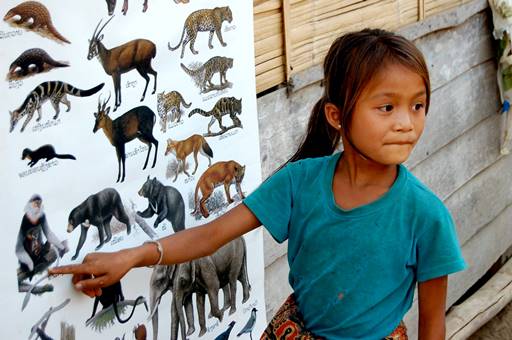 A young Lao girl identifies the endangered red-shanked douc langur during a wildlife awareness game
A young Lao girl identifies the endangered red-shanked douc langur during a wildlife awareness gameTravelling north, through the Atacama Desert and some of the driest landscapes on the planet, delirious from desert heat and wind, and hypnotised by reflective objects sparkling in the distance, my moto and I reach the Tarapacá region of northern Chile, the landscape of the Andean hairy armadillo (Chaetophractus vellerosus).
The armadillos of the high Andean plateau, or Puna, are sacred to the indigenous Aymara population. They adore them and consider these banded, hairy creatures a sign of good luck. Overexploited for traditional purposes, the armadillos are turned into guitars, rattles and other trinkets. Loved to death, they are captured and suffocated or starved so that no marring occurs to their bodies and faces. Additionally, armadillos are used in folk medicine. After being rubbed over a person’s body to absorb bad energy and disease, the armadillos are killed.
A study published in 2015 on the taxonomy of armadillos, analysing skull shape and genetics, changed the species designation of Andean hairy armadillos from C. nationi to C. vellerosus. This moved them from vulnerable on the IUCN Red List to that of least concern. Despite this the Puna armadillo is still considered endangered within Bolivia, Peru, Chile and Argentina. With little enforcement of laws regarding the protection of armadillos in Bolivia, these Xenarthrans need all the recognition and help they can get.
Dead armadillos are sold openly in markets on the border (even in front of immigration offices), where armadillos are being illegally trafficked into Bolivia from Peru and Chile. A campaign by the Wildlife Conservation Society illustrates the idea that ‘if you buy, you are an accomplice’, showing a tourist purchasing a charango, a Bolivian guitar made from the carapace of an armadillo.
Fortunately, these armadillos are now gaining the attention they need to survive thanks to the NGO Armadillos de Chile. Rominna Pasuiti, a young Chilean veterinarian and conservationist with a deep love for Xenarthrans, discovered there was almost nothing published about the armadillos found in her country. After three years of cultivating awareness, delivering education programmes in the areas where armadillos have become scarce and contributing to the scientific knowledge of the species in Chile, Pasuiti and volunteers are helping turn the tide for the survival of the Andean hairy armadillo.
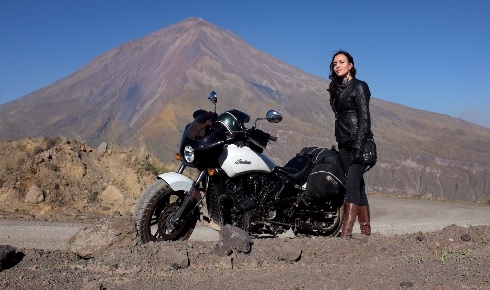 You can follow Janelle's journey on instagram: @motogypsy
You can follow Janelle's journey on instagram: @motogypsy Cat protection
Riding along the edges of volcanoes through the rugged Andes mountains on a motorcycle is an incredible adventure, with many passes above 4,000m. How impressive to know that this same extreme habitat is home to the endangered Andean cat (Leopardus jacobita), the most adorable predator you’ve never seen.
The Andean cat is a small, wild feline native to the high Andes. The estimated population of around 1,400 makes them the most threatened and least-known cat in the Americas, found only in the rugged heights of Argentina, Bolivia, Chile and Peru.
The primary prey for the Andean cat is the mountain viscacha (a rabbit-like rodent). It is believed that mountain chinchillas were once their most important prey species, but this shifted once the chinchillas became locally extinct and hunted to the brink of extinction for their fur in most of their range.
The Alianza Gato Andino (Andean Cat Alliance) is a group of volunteers working to contribute to the knowledge and conservation of the Andean cat and its habitat through innovative strategies in research, conservation, community participation and support in the management of wild areas.These volunteers dedicate much of their free time to the protection of this mountain cat, despite the fact that they will most likely never see one in their lifetime.
While studying these felids, the Andean Cat Alliance has used camera traps to record footage of them, with stunning imagery and the charismatic Leopardus jacobita gracing the scene. Through its research in all range countries of the Andean cat, information about this extremely rare and little-known species is increasing. Additionally, conservation management, education, and local community engagement in conservation are key components of the Alliance’s work. One innovative approach has been to distribute shepherding dogs to ranchers in order to protect their livestock and prevent retaliation hunting.
Riding into the mountains of Peru, from the high Andes down into the Amazon basin, my next mission was meeting with the charity Neotropical Primate Conservation (NPC). The road, much of it traversing the edge of the jungle, was challenging. This particular area on the Huallaga River is known as the ‘door of Amazonia’ and it was only in 2015 that a state of emergency was lifted from its upper river valley after 30 years. The valley was notorious as one of the most productive coca regions in the world.
Drug trafficking conflict, and the guns that go along with it, are still not uncommon in this area.
At one point I was stopped by people with rifles. They clearly were not police, nor military, but instead wore all black with tactical vests. They wanted money in exchange for ‘protecting’ the road, but weren’t asking for much – one sol, the equivalent of 25p.
Problem pets
When I arrived to meet Sam Shanee, founder of the NPC, the team were treating an endangered Andean night monkey (Aotus miconax), which had been illegally kept on a tether as a pet.
Andean night monkeys (or owl monkeys) are endemic to a small area in Peru. Being nocturnal and able to survive in fragmented forests near houses and villages, they are easy to find and catch, but they are not particularly easy to look after. Most people keeping them will only feed them scraps and fruit. Without their mixed diet of fruit, insects, leaves and buds, they eventually get sick and die. Sadly, this particular monkey had been kept as a pet for so long that it couldn’t be relocated and released. Instead it was taken to a zoo in Lima where another Andean night monkey currently resides.
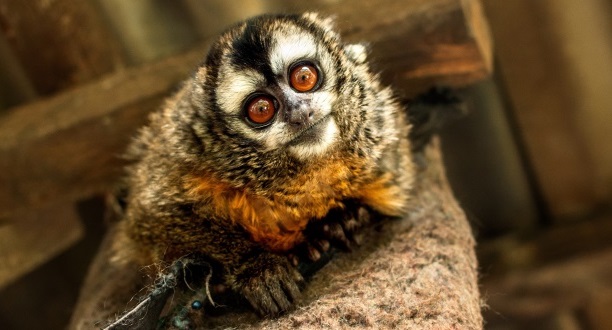 An Andean night monkey (Aotus miconax)
An Andean night monkey (Aotus miconax)The illegal trade in wild animals for pets is a global conservation and animal-welfare concern. As if habitat loss and environmental degradation were not enough of a threat, wildlife also have a price on their heads. Wild animals for sale by the roadside are a common sight in South America, where trading and the practice of keeping them as pets has been around for a long time. Many people purchase these wild animals out of pity, believing they can offer them a better life. However, their money is perpetuating the trade and usually the buyer has no idea how to care for the animal appropriately, especially as it transitions into adulthood.
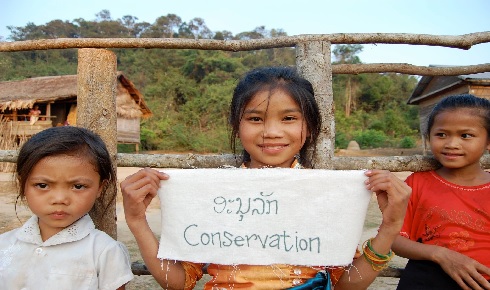 An education and outreach programme in a remote village on the border of Laos and Vietnam.
An education and outreach programme in a remote village on the border of Laos and Vietnam.Many people ask me if I’m afraid to live my life this way – alone on the road on a motorcycle seeking the stories of wildlife protection. The truth is, before I started doing this I felt tremendous despair for the state of our planet and with my own inaction. I feel far more fear of doing nothing, of pretending like the atrocities happening to our planet and its creatures don’t affect me.
We have massive obstacles to overcome in the protection of our planet and its inhabitants, but one thing is clear – anything helps. Whether it’s conserving an entire species, a population, an ecosystem, or an individual animal or small plot of land, we can all do our best to help biodiversity where we are and support those who are doing so elsewhere.
You can follow Janelle Kaz’s journey on Instagram @motogypsy or on her website www.motogypsy.org.
Janelle Kaz is a biologist, journalist and environmental advocate who has spent the last five years travelling across three continents. Her mission is to document and assist groups taking action to protect ecosystems and the people who depend on them.


